D.G. Rossetti's ownership of Botticelli's 'Smeralda Brandini'
by GAIL S.WEINBERG

when Herbert h?rne pubUshed his pioneering biogra phy of Sandro BotticeUi in 1908,1 he stressed that 'among the first to reaUse in some definite measure the pecuUar character and charm of BotticeUi's artwere Dante Gabriel Rossetti and the Pre-RaphaeUtes'.2 WilUam Michael Ros setti wrote toHome:
In 1849, when my brother with Holman Hunt first visited Paris, he observed in the Louvre, with particular pleasure, one or two pictures by BotticeUi, and talked about them on his return After that, BotticeUi remained in abeyance with him for some years; but cer tainly not forgotten. In i860, I for the first time visited Florence, and was greatly struck by the BotticeUis ? especiaUy by the Birth of Venus. On my return I spoke about those works to my brother and others. This refreshed his interest inBotticeUi; and in 1867, he bought that Uttle picture of which you speak ..3
The picture towhich WilUam Michael Rossetti refers is the painting now titled Portrait of Smeralda Brandini (Fig. 18) and stiU ascribed to BotticeUi. Formerly owned by the Parisian coUector the Comte de Pourtal?s, before it passed into Rossetti's coUection, itwas sold by the painter in 1880 to his patron Constantine Alexander Ionides, who bequeathed it in 1900, along with his coUection of old-master and French nineteenth-century paintings, to the Victoria and Albert Museum in London/ The circumstances of Rossetti's acquisition of the BotticeUi, its influence on his own paint ings, his attempts to exhibit and seU the picture impeUed by his recurrent need for money, and the circumstances of his eventual sale to Ionides, present an interesting narrative of the ownership of a 'pre-RaphaeUte' painting by one of the founding members of the Pre-RaphaeUte Brotherhood.
Notoriously, for a painter admittedly influenced by early ItaUan paintings, and for a person of largely ItaUan ancestry, Dante Gabriel Rossetti never visited Italy, but this did not mean that his exposure to early ItaUan painting was confined to his important trip to France and Belgium with Holman
Hunt in 1849, and his subsequent travels.5 Malcolm Warn er has pointed out that the very bu?ding inTrafalgar Square in which the pupfls of the Royal Academy, including Rossetti, studied during the late 1840s also housed the coUection of the National GaUery, just then beginning to acquire and display early ItaUan and early Flemish paintings.6
From the start of the nineteenth century, before the foun dation of the National GaUery in 1824, or even of its precursor, the Dulwich Picture GaUery, which opened to the pubUc in 1817, individual coUectors in England, such as theRev. John Sanford and the keeper of the Print Room at the British Museum, WilUam Young Ottley, were not only coUecting early ItaUan paintings, but displaying them in pubUc. The vehicle for the display was, from 1815 onwards for northern paintings, and from 1816 onwards for ItaUan and Spanish paintings, the annual old-master exhibition presented in London by the British Institution, the recently founded rival of the Royal Academy.7 As early as 1816, Sanford showed there a painting of the Assumption of theVir gin, then and now attributed to Fra AngeUco (now in the IsabeUa Stewart Gardner Museum, Boston) and, in 1847, the painting was once again exhibited at the British Institution.8
During 1848, the year in which the Pre-RaphaeUte Brotherhood was founded, the British Institution fiUed its middle room, into which viewers entered directly by the staircase from the ground floor, with a series of ItaUan and Flemish paintings described as 'anovelty . . .namely a series of pictures from the time of Giotto and Van Eyck'.9 There isno evidence that the Pre-RaphaeUtes attended the exhibi tion, but it contained what can only be caUed a 'critical mass' of early ItaUan and Flemish paintings, including the magical Wilton diptych (National GaUery, London)10 and a Portrait of a lady, attributed to Sandro BotticeUi and owned by Henry Seymour, which can be identified with a profile portrait now in Japan and ascribed to a foUower of BotticeUi.11 The works in the middle room were deemed so esoteric that the artists were provided with their dates of birth and death, an aid not needed in the case of the presumably better-known
I am grateful toMark Evans, senior curator of paintings at the Victoria and Albert Museum, for having sentme the text of an unpublished lecture which he delivered at theMuseum on Botticelli's Portrait of Smeralda Brandini, and toNicola Costaras, senior paintings conservator at the Victoria and Albert Museum, for having exhib ited the portrait unframed in the conservation laboratory to me and to Stephan Wolohojian, curator of paintings, sculpture and decorative arts at the Fogg Art Museum.
1H. Home: Botticelli: Painter ofFlorence, London 1908, reprinted Princeton 1980.
2 Ibid., p.xvii. i Ibid., pp.xvii?xviii.
4 CM. Kauffmann: Victoria andAlbert Museum Catalogue ofForeign Paintings: Before 1800,New Haven and London 1973, I, pp.37-39.
20 JANUARY 2OO4 CXLVI THE BURLINGTON MAGAZINE
5 G.S. Weinberg: '"Looking backward": opportunities for the Pre-Raphaelites to see "pre-Raphaelite" art', inM. Watson, ed.: Collecting thePre-Raphaelites: The Anglo-American Enchantment, Aldershot 1997, pp.5-62.
6 M. Warner: 'The Pre-Raphaelites and theNational Gallery', Huntington Library Quarterly 55, no.i (Winter 1992), pp.i-11.
7 F. Haskell: The Ephemeral Museum: Old Master Paintings and theRise of theArt Exhibition, London 2000. See also P. Fullerton: 'Patronage and Pedagogy: The British Institution in the Early Nineteenth Century', Art History 5, no.i (March 1982), pp.59-72; see also A. Graves: 'The British Institution', Artfoumal 72 (1910), pp.336-41 and 377-81.
8 P. Hendy: European andAmerican Paintings in the Isabella Stewart Gardner Museum, Boston 1974, pp.2-5.
is collaborating with JSTOR to digitize, preserve, and extend


18. Portrait ofSmeralda Brandini, by Sandro BotticeUi. 1471. Panel, 65.7 by 41 cm. (Victoria and Albert Museum, London).
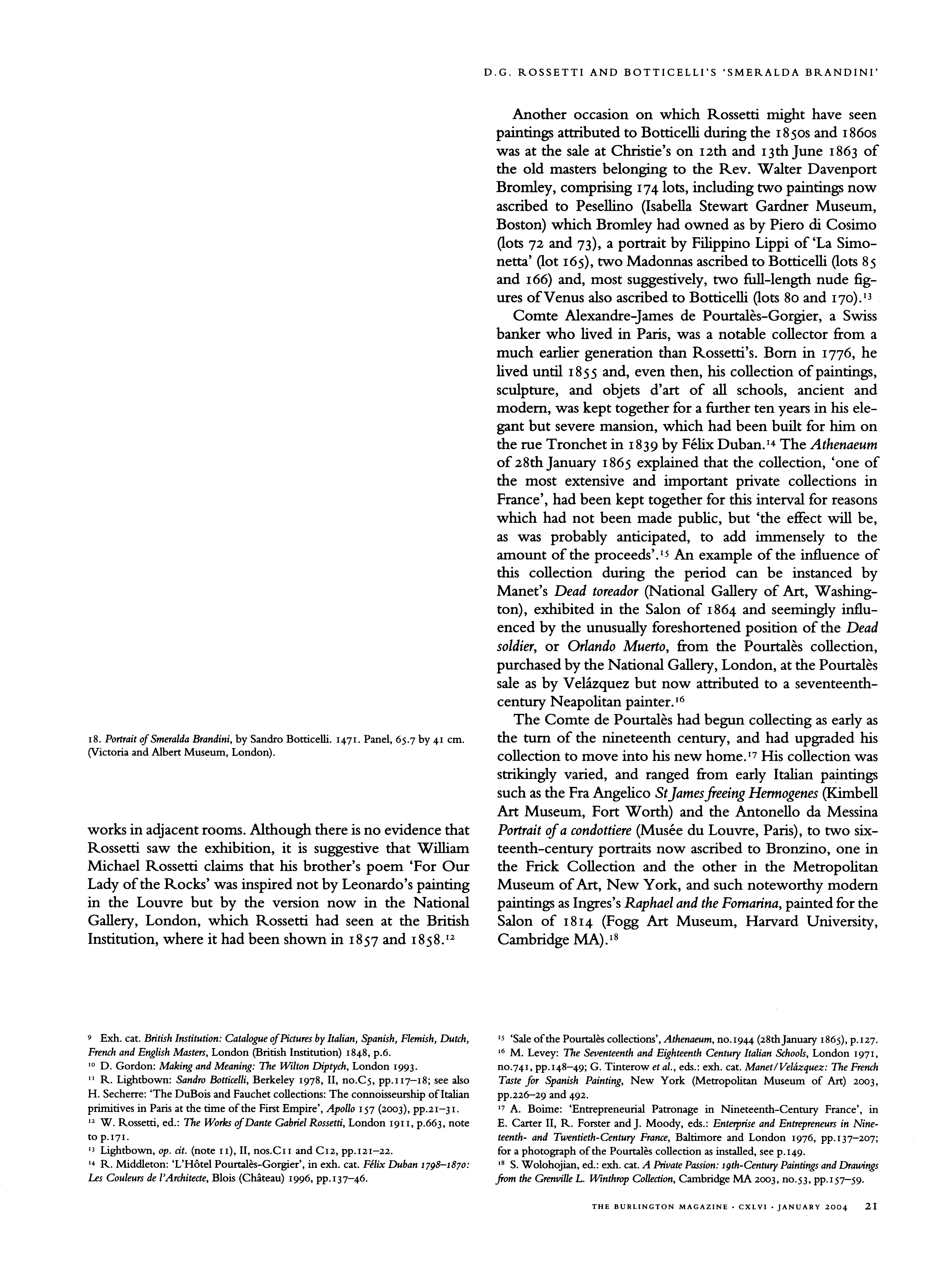
works in adjacent rooms. Although there isno evidence that Rossetti saw the exhibition, it is suggestive thatWilUam Michael Rossetti claims that his brother's poem 'For Our Lady of theRocks' was inspired not by Leonardo's painting in the Louvre but by the version now in the National GaUery, London, which Rossetti had seen at the British Institution, where it had been shown in 1857 and 1858.12
Another occasion on which Rossetti might have seen paintings attributed to BotticeUi during the 1850s and 1860s was at the sale at Christie's on 12th and 13th June 1863 of the old masters belonging to the Rev. Walter Davenport Bromley, comprising 174 lots, including two paintings now ascribed to PeseUino (IsabeUa Stewart Gardner Museum, Boston) which Bromley had owned as by Piero di Cosimo (lots 72 and 73), a portrait by FiUppino Lippi of'La Simo netta' (lot 165), two Madonnas ascribed to BotticeUi (lots 85 and 166) and, most suggestively, two fuU-length nude fig ures of Venus also ascribed to BotticeUi (lots 80 and 170).I3
Comte Alexandre-James de Pourtal?s-Gorgier, a Swiss banker who Uved in Paris, was a notable coUector from a much earner generation than Rossetti's. Born in 1776, he Uved until 1855 and, even then, his coUection of paintings, sculpture, and objets d'art of aU schools, ancient and modern, was kept together for a further ten years in his ele gant but severe mansion, which had been built for him on the rue Tronchet in 1839 by F?lix Duban.14 The Athenaeum of 28th January 1865 explained that the coUection, 'one of the most extensive and important private coUections in France', had been kept together for this interval for reasons which had not been made pubUc, but 'the effect wiU be, as was probably anticipated, to add immensely to the amount of the proceeds'.15 An example of the influence of this coUection during the period can be instanced by Manet's Dead toreador (National GaUery of Art, Washing ton), exhibited in the Salon of 1864 and seemingly influ enced by the unusuaUy foreshortened position of the Dead soldier, or Orlando Muerto, from the Pourtal?s coUection, purchased by theNational GaUery, London, at the Pourtal?s sale as by Velazquez but now attributed to a seventeenth century NeapoUtan painter.16
The Comte de Pourtal?s had begun coUecting as early as the turn of the nineteenth century, and had upgraded his coUection tomove into his new home.17 His coUection was strikingly varied, and ranged from early ItaUan paintings such as the Fra AngeUco StJames freeing Hermogenes (KimbeU Art Museum, Fort Worth) and the AntoneUo daMessina Portrait of a condottiere (Mus?e du Louvre, Paris), to two six teenth-century portraits now ascribed to Bronzino, one in the Frick CoUection and the other in the MetropoUtan Museum of Art, New York, and such noteworthy modern paintings as Ingres's Raphael and theFomarina, painted for the Salon of 1814 (Fogg Art Museum, Harvard University, Cambridge MA).18
9 Exh. cat. British Institution: Catalogue ofPictures by Italian, Spanish, Flemish, Dutch, French and English Masters, London (British Institution) 1848, p.6.
10D. Gordon: Making andMeaning: The Wilton Diptych, London 1993.
11R. Lightbown: Sandro Botticelli, Berkeley 1978, II, no.C5, pp.117?18; see also H. Secherre: 'The DuBois and Fauchet collections: The connoisseurship of Italian primitives in Paris at the time of the First Empire', Apollo 157 (2003), pp.21-31.
12W. Rossetti, ed.: The Works ofDante Gabriel Rossetti, London 1911, p.663, note top.171.
13 Lightbown, op. at. (note 11), II, nos.Cn and C12, pp.121?22.
14R. Middleton: 'L'H?tel Pourtal?s-Gorgier', in exh. cat. F?lix Duban 1798?1870: Les Couleurs de l'Architecte, Blois (Ch?teau) 1996, pp.137?46.
15 'Sale of the Pourtal?s collections', Athenaeum, no. 1944 (28th January 1865), p. 127.
16M. Levey: The Seventeenth and Eighteenth Century Italian Schools, London 1971, no.741, pp.148?49; G. Tinterow et al., eds.: exh. cat.Manet/Velazquez: The French Taste for Spanish Painting, New York (Metropolitan Museum of Art) 2003, pp.226-29 and 492.
17A. Boime: 'Entrepreneurial Patronage in Nineteenth-Century France', in E. Carter II,R. F?rster and J.Moody, eds.: Enterprise and Entrepreneurs inNine teenth- and Twentieth-Century France, Baltimore and London 1976, pp.137?207; for a photograph of the Pourtal?s collection as installed, see p. 149. 18S.Wolohojian, ed.: exh. cat. A Private Passion: icth-Century Paintings andDrawings from theGrenville L. Winthrop Collection, Cambridge MA 2003, no.53, pp.157?59.
19. Lapia de' Tolomei, by Dante Gabriel Rossetti. 1868-80.
104.8 by 120.6 cm. (Spencer Museum of Art, University of Kansas, Lawrence).

PubUcity for the coUection was lavish, including the pub Ucation of a portfoUo of sixty photographs, Souvenirs de la Galerie Pourtal?s, issued by Goup? in 1863, and four articles on different aspects of the coUection, iUustrated with prints, pubUshed in the Gazette des Beaux-Arts in monthly issues from November 1864 to February 1865.19 The sale itself occupied several months, the paintings and drawings portion beginning on 27th March 1865 and extending over thirty days.20
The sales catalogues were ava?able not only in Paris, but throughout Europe, the paintings catalogues being distrib uted in Brussels, BerUn, Vienna, Frankfurt, St Petersburg and The Hague (atVan Gogh, print dealers), and to several outlets in London, including Ernest Gambart, who was Rossetti's dealer at the time.21 The description in 1865 of the BotticeUi which was to enter Rossetti's coUection is identi cal to the description of the same painting, Usted as no. 5 in JJ. DuBois's Description des tableauxfaisant partie des collections
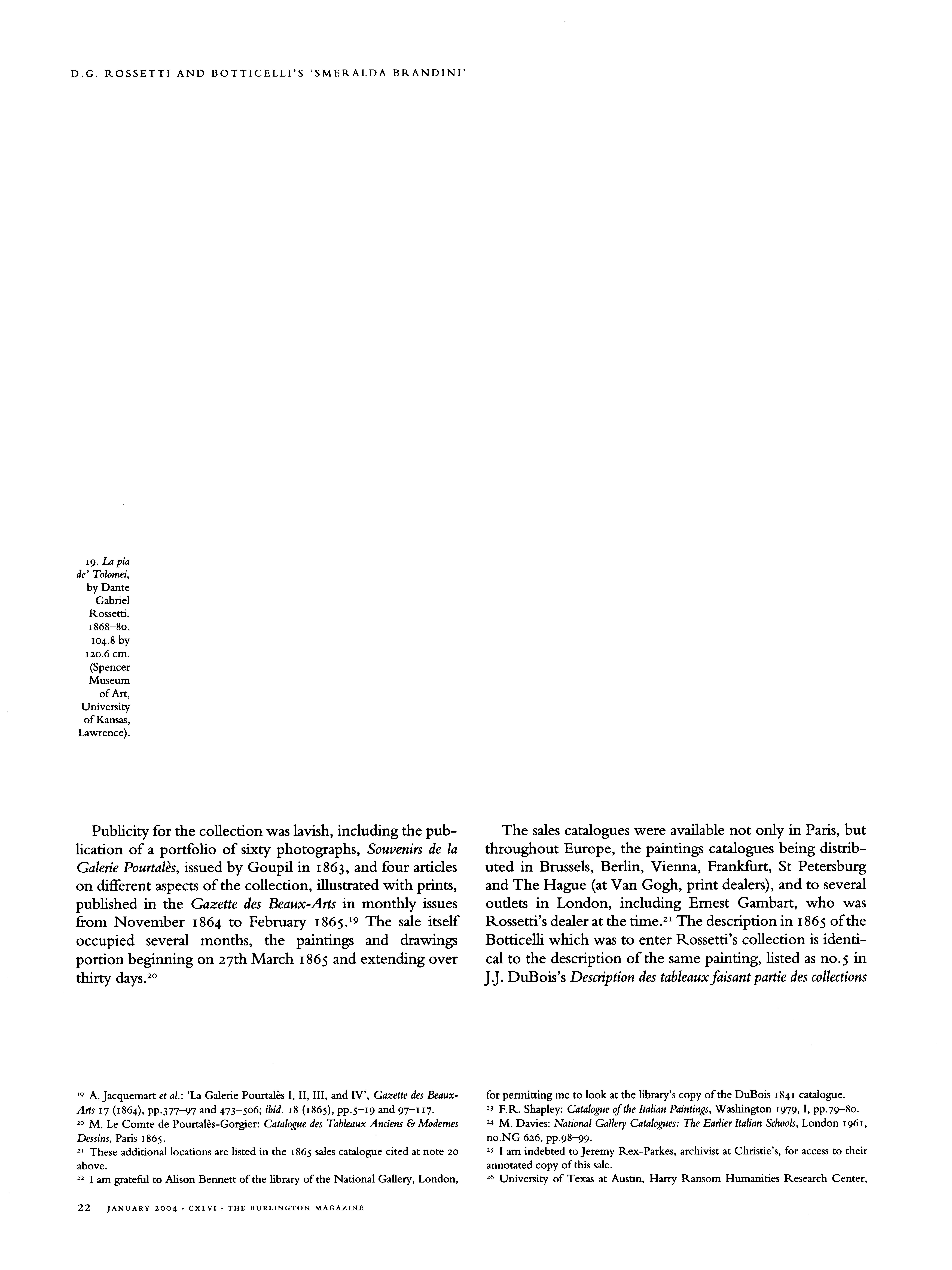
19A. Jacquemart et al: 'LaGalerie Pourtal?s I, II, III, and IV, Gazette des Beaux Arts 17 (1864), pp. 377-97 and 473-506; ibid. 18 (1865), pp. 5-19 and 97-117.
20M. Le Comte de Pourtal?s-Gorgier: Catalogue des Tableaux Anciens &Modernes Dessins, Paris 1865.
21These additional locations are listed in the 1865 sales catalogue cited at note 20 above.
22 I am grateful toAlison Bennett of the library of the National Gallery, London,
22
for permitting me to look at the library's copy of the DuBois 1841 catalogue.
23F.R. Shapley: Catalogue of the Italian Paintings, Washington 1979,1, pp.79-80.
24M. Davies: National Gallery Catalogues: The Earlier Italian Schools, London 1961, no.NG 626, pp.98-99.
25 I am indebted to Jeremy Rex-Parkes, archivist at Christie's, for access to their annotated copy of this sale.
26 University of Texas at Austin, Harry Ransom Humanities Research Center,
de M. Pourtal?s-Gorgier, written in 1841.22 The portrait depicts a young woman sitting in an enclosed space, her hair tucked into awhite cap, and her crimson dress covered with a translucent white over-robe. In one hand she holds a handkerchief, a common emblem of status, wh?e the other hand rests on the outer opening of the enclosure.
The BotticeUi portrait, identified in the catalogue as a portrait of Smeralda BandineUi, sold for 3,400 francs to Goup?, who, at that time, maintained an office in London.
The price was not meagre, especiaUy in comparison with a portrait of a young man, attributed toMasaccio in the Pourtal?s catalogue and sold to Baron Triqueti for 2,600 francs; it isnow in theNational GaUery of Art, Washington, attributed to BotticeUi.23 Such amistaken attribution was not unusual for the time; compare, for instance, BotticeUi's Portrait of a young man which had been bought by the National GaUery, London, from the Northwick coUection in 1859 as the work ofMasaccio.24
The portrait of Smeralda then disappears from sight for two years, perhaps being kept for part of that time in Goupil's London office, until it resurfaced in the sale at Christie's of P. and D. Colnaghi's stock beginning on nth March 1867, lot 1970, as 'BotticeUi, Portrait of Smeralda BandineUi, from the Portales [sic] coUection', to be sold on 23rd March 1867, the eleventh and last day of the sale.25
In a letter probably written on 22nd March 1867, Ros setti wrote to his secretary, Charles Augustus HoweU:
My dear HoweU: Iwish ifyou attend that sale tomorrow you'd letme know the result at once, by message or com ing. If the BotticeUi goes cheap, of course, I'd Uke to buy it if practicable but perhaps I'd better give up the idea. If very cheap, Iwould ask you to get it and pay you in a day or two.26
The date of the Christie's sale, 1867, preceded by a few years the inception of the craze for BotticeUi, prefigured by the pubUcation, in the Fortnightly Review of July 1868, of Swin burne's Notes onDesigns of theOld Masters at Florence, which aUudes to BotticeUi's 'faint and almost painful grace',27 and provoked by Walter Pater's essay 'A Fragment on Sandro BotticeUi', pubUshed in the Fortnightly Review of August 1870,28 and reprinted in Studies of theHistory of theRenais sance.29 It isprobable, however, thatHoweU was able to pur chase the BotticeUi for the strikingly smaU sum, even for the period, of ?20, not only because the sitter was so simply dressed and coiffed, but because the surface of the painting shows evidence of a curious form of disfiguration, having been incised through the eyes and mouth.
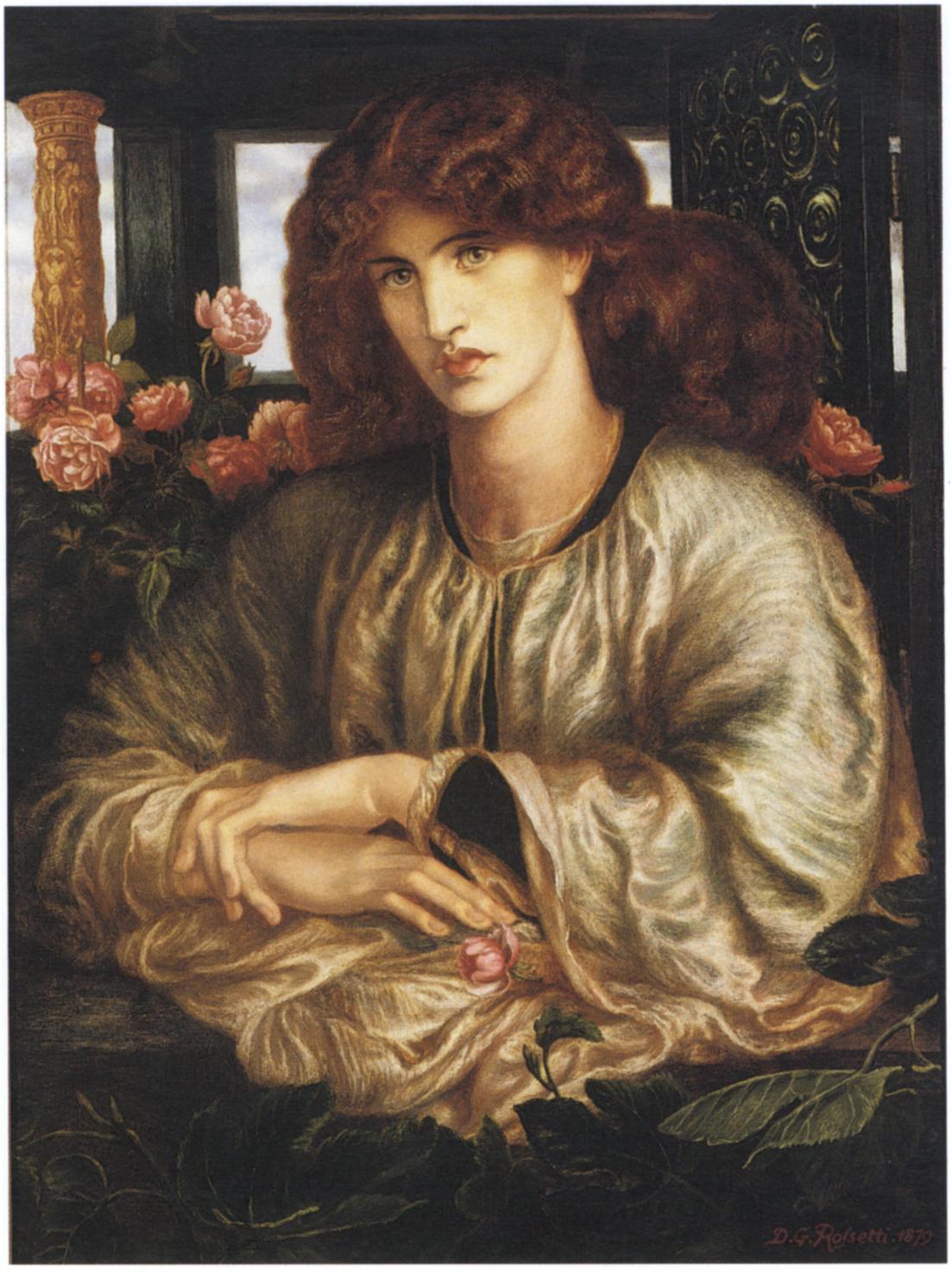
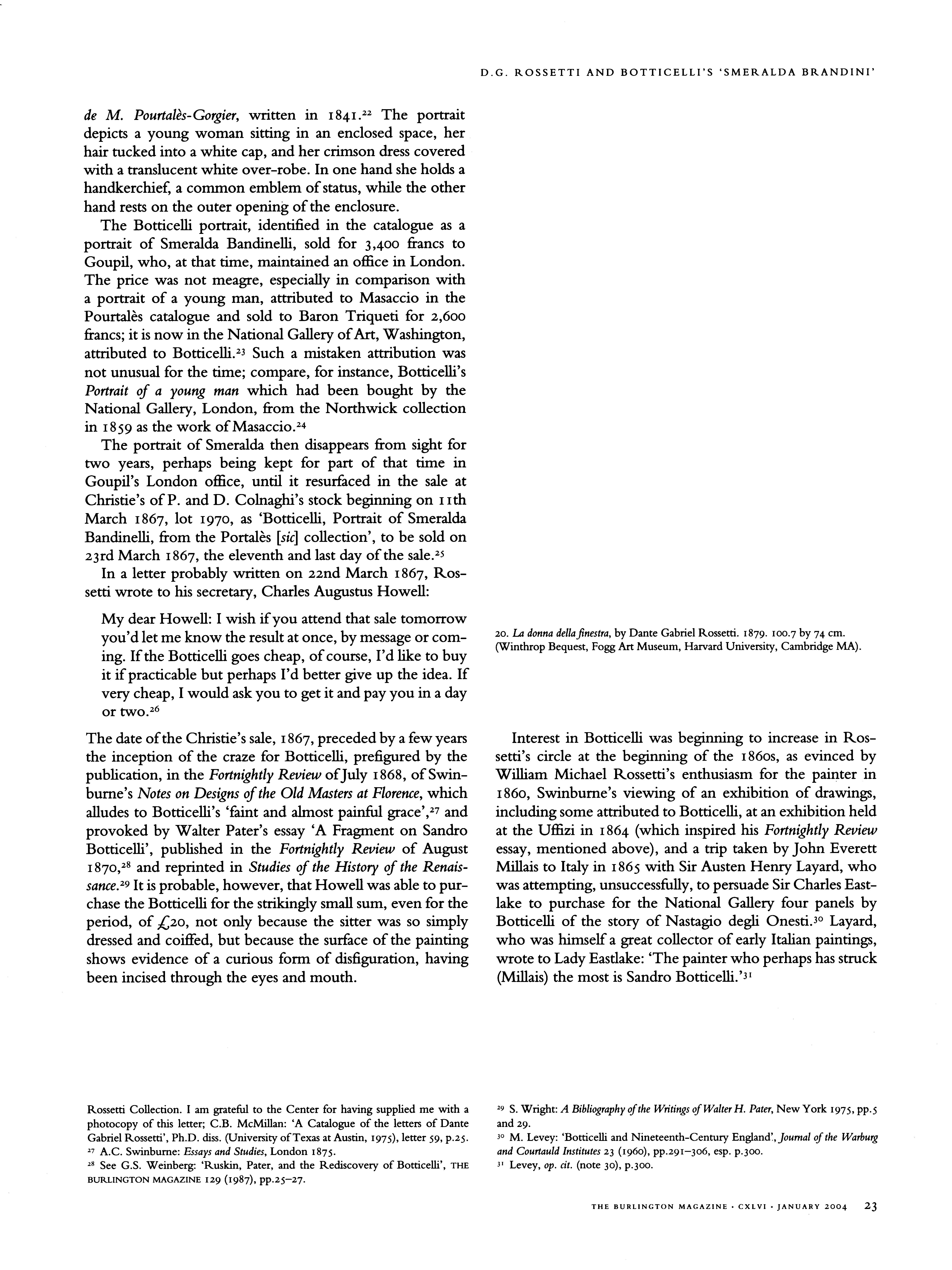
Rossetti Collection. I am grateful to the Center for having supplied me with a photocopy of this letter; C.B. McMillan: 'A Catalogue of the letters of Dante Gabriel Rossetti', Ph.D. diss. (University of Texas atAustin, 1975), letter 59, p.25.
27A.C. Swinburne: Essays and Studies, London 1875.
28 See G.S. Weinberg: 'Ruskin, Pater, and the Rediscovery of BotticeUi', the BURLINGTON MAGAZINE 129 (1987), pp.25-27.
Interest in BotticeUi was beginning to increase inRos setti's circle at the beginning of the 1860s, as evinced by WilUam Michael Rossetti's enthusiasm for the painter in i860, Swinburne's viewing of an exhibition of drawings, including some attributed to BotticeUi, at an exhibition held at the Uffizi in 1864 (which inspired his Fortnightly Review essay, mentioned above), and a trip taken by John Everett MiUais to Italy in 1865 with Sir Austen Henry Layard, who was attempting, unsuccessfuUy, to persuade Sir Charles East lake to purchase for the National GaUery four panels by BotticeUi of the story of Nastagio degU Onesti.30 Layard, who was himself a great coUector of early ItaUan paintings, wrote to Lady Eastlake: 'The painter who perhaps has struck (MiUais) the most is Sandro BotticeUi.'31
29 S.Wright: A Bibliography of theWritings ofWalter H. Pater, New York 1975, pp.5 and 29.
30M. Levey: 'BotticeUi and Nineteenth-Century England', Journal of theWarburg and Courtauld Institutes 23 (i960), pp.291?306, esp. p.300.
31 Levey, op. cit. (note 30), p. 300.
Undoubtedly, part of the lure of the painting for Ros setti was the exalted provenance, which had been noted in the Christie's sales catalogue. On the back of the painting, Rossetti affixed a label in his hand, identifying it as coming 'from the Pourtal?s coUection'.32 He also aUuded to the painting which he owned in a note he added to his poem on BotticeUi's Primavera, written in 1880 and inspired by a photograph given to him by Charles Fairfax Murray. Referring to the central figure, usuaUy identified asVenus, he stated that 'the same lady, here surrounded by the Masque of Spring, is evidently the subject of a portrait by BotticeUi formerly in the Pourtal?s coUection, Paris. This portrait is inscribed "Smeralda BandineUi".'33 An inscription at the bottom of the painting reads 'Smeralda Di . . . BandineUi MogUe Di . . .BandineUi'. This inscription is anachronistic in itself, because the sculptor Baccio Bandi neUi only assumed that name in 1530, claiming to be descended from the noble Sienese family. The portrait today is usuaUy entitled Smeralda Brandini, the name of the sculptor's grandmother. However, the inscription ismuch later, and there is no evidence that the sitter had any con nection with the sculptor.34
Some years later, recaUing the purchase of the BotticeUi at Christie's, HoweU remembered that it 'cost me originaUy ^22 and Gabriel paid ?4 more to have it cleaned'.35 This discrepancy might indicate a purchase price of twenty guineas. The conservation department at the Victoria and Albert Museum has found evidence of professional cleaning and retouching on the painting.36 WilUam Michael Ros setti noted in his diary for 26th March 1867 that 'Gabriel has received the BotticeUi (female half-figure) which he bought at Christie's (Colnaghi's sale) the other day for ?20',37 and, more disturbingly, that by 29th March Gabriel had 'painted on the back of his BotticeUi, and improved it very sensibly - the previous condition of this part of the picture being obviously wrong, and I understand injured by previous cleaning'.38
The V. & A. has found evidence of overpaint ing of a somewhat opaque white at the back of the head of Smeralda BandineUi but cannot identify this as specific to the nineteenth century. However, Rossetti himself con fesses the fact of his interference in a letter to HoweU: 'My dear HoweU; I forgot to ask Kate to teU you not to shriek when you see the BotticeUi if others are here ? Ihave been restoring the head-dress, but don't mean to teU.'39 EUisWaterhouse wrote of Rossetti's BotticeUi that 'apart for itspossible inspiration for some ofRossetti's fancy female half-lengths, its presence inRossetti's house certainly played
some part in fostering the BotticeUi cult, which became rampant during the years when he Uved at 16 Cheyne Walk'.40 The next BotticeUi that Rossetti scrutinised with intent to purchase was the Mystic Nativity, now in the National GaUery, London.41 Gabriel wrote to his brother in a letter from PenkiU Castle, assigned the date of 26th Sep tember 1868, that 'I spent a couple of hours in the Exhibi tion at Leeds, where there are a good many things worth seeing ? amost glorious Sandro BotticeUi (Nativity), a very fine Carpaccio caUed Landing of Queen Cornaro inCyprus, and splendid heads by Titian, Moroni, BeUini, and Velasquez'.42 The Mystic Nativity, then in the FuUer Mait land coUection, was exhibited in a loan show of old-master paintings at theRoyal Academy in 1871. It stirred Ruskin to his first pubUc praise of BotticeUi, which was foUowed by an article by Sidney Colvin explaining the painting's obscure Greek inscription and signature.43
By the early 1870s, Rossetti's personal circumstances ? he suffered a nervous breakdown in the summer of 1872 - had transformed him from potential buyer to potential seUer of his old masters, of which the BotticeUi was now the most valuable. In the foUowing year's exhibition of old masters at the Royal Academy, Rossetti's BotticeUi was shown, Usted as number 270, the last painting in the exhibition catalogue, except for those in the haU, and thus an afterthought inspired by MiUais's exhibition in the same show of a portrait he owned by Holbein (no.52). Such exposure at the Royal Academy was often considered a prelude to sale.
By 5th July 1872, WilUam Michael Rossetti hoped that HoweU had found a buyer for the BotticeUi in the great coUector of early ItaUan paintings and patron of the Pre RaphaeUtes, WilUam Graham,44 writing toWilUam BeU Scott that 'HoweU is trying to dispose of the BotticeUi. He had supposed that Graham would be sure to buy it, but now finds that Graham decUnes, on the ground that Gabriel would soon be weU . . . and would not Uke to find the picture gone from his possession.'45 In a letter to HoweU of 10th July, WilUam Michael speculated on a price for the BotticeUi: 'I had understood that the price that you had expected to attain was ??100 upwards. If?100 and no more can be obtained, I think that it should be accepted without hesitation: ?90 or 85 should I think also be accepted ... if less than .?85 is offered, would you please consult me ? or if then practicable Gabriel.'46
Two months later, on nth September 1872, Charles Augustus HoweU notified WilUam Michael Rossetti that the BotticeUi had in effect been kidnapped, removed by
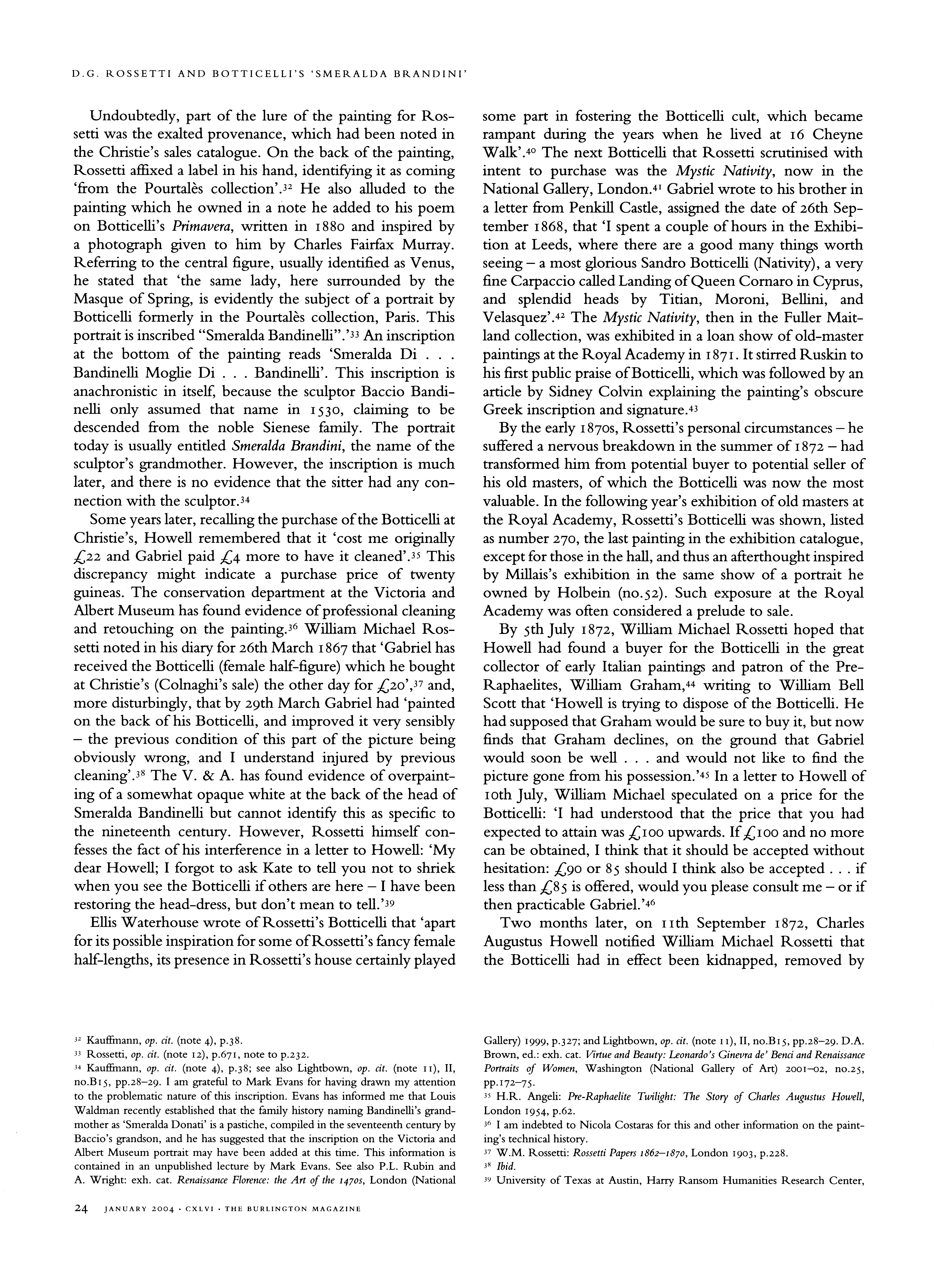
32Kauf?mann, op. cit. (note 4), p.38.
33Rossetti, op. cit. (note 12), p.671, note to p.232.
34Kauffinann, op. cit. (note 4), p.38; see also Lightbown, op. cit. (note 11), II, no.Bi5, pp.28-29. I am grateful toMark Evans for having drawn my attention to the problematic nature of this inscription. Evans has informed me that Louis Waldman recently established that the family history naming Bandinelli's grand mother as 'Smeralda Donati' is a pastiche, compiled in the seventeenth century by Baccio's grandson, and he has suggested that the inscription on the Victoria and Albert Museum portrait may have been added at this time. This information is contained in an unpublished lecture by Mark Evans. See also P.L. Rubin and A. Wright: exh. cat. Renaissance Florence: theArt of the 1470s, London (National
Gallery) 1999, p.327; and Lightbown, op. cit. (note 11), II, no.Bi5, pp.28?29. D.A. Brown, ed.: exh. cat. Virtue and Beauty: Leonardo's Ginevra de' Bend andRenaissance Portraits of Women, Washington (National Gallery of Art) 2001?02, no.25, pp. 172-75.
35H.R. Angeli: Pre-Raphaelite Twilight: The Story of Charles Augustus HoweU, London 1954, p.62.
36 I am indebted toNicola Costaras for this and other information on the paint ing's technical history.
37W.M. Rossetti: Rossetti Papers 1862-1870, London 1903, p.228.
38 Ibid.
3yUniversity of Texas at Austin, Harry Ransom Humanities Research Center,

21. The day dream, by Dante Gabriel Rossetti. 1878. Pastel and black chalk, 105.8 by 77.6 cm. (Ashmolean Museum, Oxford).
HoweU's partner, RaffaeUo Pinti, who was buying for the King of Italy, and who had 'sent it off to his Majesty last Friday by passenger train'.47 'The news about the BotticeUi flurries me a Uttle', WilUam Michael repUed. 'Gabriel may be back almost any day now and I should be very sorry ifhe found the picture gone . this BotticeUi affairwiU keep me in hot water tiU I see the fuU end of it. ..'48 InNovember and December of 1872, the BotticeUi was stiU circulating around Italy, toHoweU's distress; 'Hang the BotticeUi busi ness',49 he wrote on 2nd November 1872, and on 17th December, '"that damned BotticeUi" has reaUy made me hate the noble master. It is of course quite safe, but as you say, damn the thing!'50
Rossetti Collection. I am grateful to the Center for having supplied me with a photocopy of this letter;McMillan, op. cit. (note 26), no.49, p.23.
40 E.Waterhouse: 'Holman Hunt's "Giovanni Bellini" and the Pre-Raphaelites' own early Italian pictures', the Burlington magazine 123 (1981), pp.473-77. Rossetti moved into 16Cheyne Walk on 24th October 1862 and lived there until his death in 1882.
41Davies, op. cit. (note 24), no.NG 1034, pp. 103-08.
42O. Doughty and J.R. Wahl, eds.: Letters ofDante Gabriel Rossetti 1861-1870, Oxford 1965-67, II, letter 786, pp.664-65.
43 S. Colvin: 'The Date and Superscription ofMr. Fuller Maitland's Botticelli', The Academy (1871), pp. 130-32.
44 For information on William Graham and his collection, see O. Garnett: 'The
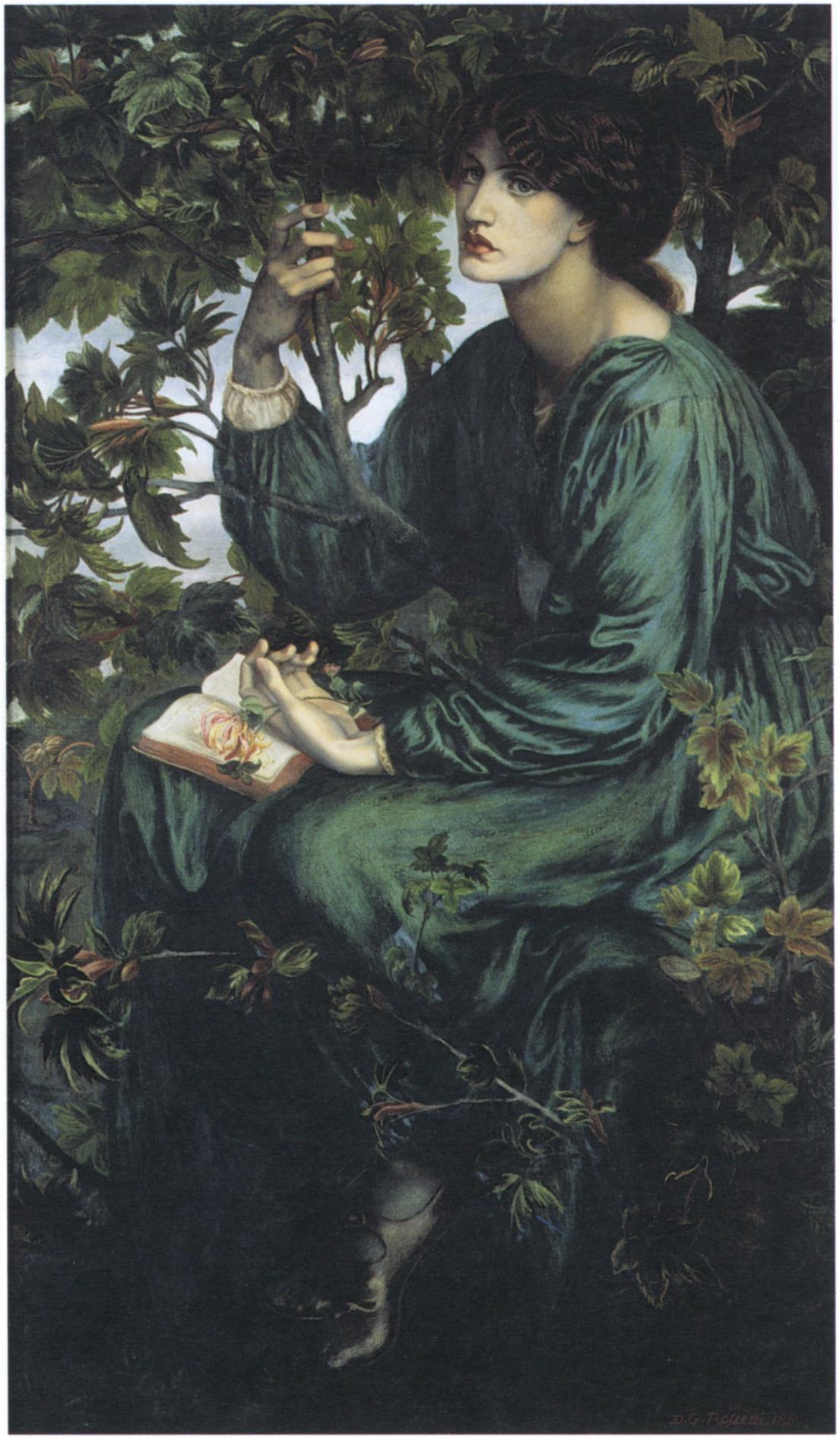

Although the BotticeUi was not sold to Graham at this time, in 1873 he bought Rossetti's own painting La Ghirlandata, now in the Gu?dhaU Art GaUery, London. Throughout his Ufe, Rossetti was able to attain far greater prices for his own works than he could obtain for his Botti ceUi, and La Ghirlandata was bought by Graham for ?840.51 Begging for a companion piece to La Ghirlandata, Graham
Letters and Collection of William Graham ? Pre-Raphaelite Patron and Pre RaphaeUte Collector', The Sixty-Second Volume of theWalpole Society (2000), pp. 145-86 and 287-88.
45R.W. Peattie, ed.: Selected Letters ofWilliam Michael Rossetti, University Park 1990, p.290.
46 Ibid., p.292.
47 Angeli, op. cit. (note 35), p.64.
48W.M. Rossetti to C.A. Howell, in Peattie, op. cit. (note 45), pp.300-01.
49 Angeli, op. cit. (note 35), p.66.
5? Ibid.
51V. Surtees: Dante Gabriel Rossetti 1828-1882. The Paintings andDrawings: A Cata logueRaisonn?, Oxford 1971,1, no.232, p. 130.
told HoweU: 'let it be a fair beautiful woman, as Uke Botti ceUi as possible, for this one is exactly Uke BotticeUi, and if Rossetti wiU only paint me pictures of this class IwiU buy nothing else but his, and any old master you can get me.'52
The BotticeUi left a stronger imprint on two paintings that Rossetti worked on from the late 1860s to 1880: La pia de' Tolomei (Fig. 19) and, even more closely, La donna della finestra (Fig. 20).53
Leon?e Ormond has pointed out that the costume of La pia dey Tolomei was copied 'from a portrait in his own col lection, wrongly beUeved to be a portrait of Smeralda BandineUi'.54 Rossetti had written to Aglaia Coronio on 17th June 1868: 'Dear Mrs. Coronio, I asked you lately whether you had or knew of any Indian musUn of a pecuUar yeUowish tinge and you said no. Ihave since had to adopt a whiter kind for the purpose ... it is for a dress which Janey Morris ismaking up for one of the pictures I am doing from her.'55 But an even closer comparison is afforded by La donna dellafinestra which Rossetti began in 1870 and sold to the pubUsher F.S. EUis in 1879 for ?420.56 In this painting every component is derived from Rossetti's BotticeUi: the costume, sewn by his sitter, Jane Morris, the sitter's pose, the composition and the architectural setting, although every element has been subjected to the relentless elaboration of Rossetti's late style.
Another of Rossetti's 'fancy female' pictures, The day dream (Fig.22),57 was the vehicle for the eventual sale of Rossetti's BotticeUi to his friend and patron Constantine Ionides. The painting was commissioned in the autumn of 1879 and finished in the summer of 1880. Depicting Jane Morris seated in a sycamore tree, it derives from a drawing by Rossetti, showing the figure only down to knee length (Fig.21). Although the finished painting is a handsome dec orative harmony in green, the trees have been elaborated, the features coarsened, and the lower legs down to the feet have been unconvincingly extended.58
During this period, Ionides came in and out of Rossetti's house freely, and by 16thMay 1880 Rossetti wrote happ?y to Jane Morris: 'My dear Janey, News, alas is dearthly with me too except the startling fact that I have turned dealer! i.e. to the extent of seUing that BotticeUi Portrait to Const. Ionides for 300 guineas. He fancied itmuch, so I didn't refuse. He was dining with me, and Aleco with him on Tuesday last. He is a Briton and no mistake ? his being
Greek must be amatter of business the idea of seUing pic tures that you do not have to paint is certainly a great one. IfM. Angelo had once smelt blood in that way, we should never have had the Sixtine Chapel!'59
A series of letters from Rossetti to Ionides written during the autumn of 1879 and the spring of 1880 estabUshes the context of this transaction. As was his habit and necessity, Rossetti was paid in instalments by Ionides, receiving or extracting money at intervals, and estabUshing his constant need for 'tin'. It is no surprise to read Rossetti's letter to Ionides of 12thMay 1880:
My dear Ionides
Idid not enter into the question of the BotticeUi portrait yesterday evening, but as you seem to have faUen in love with it, and as I should prefer your having the refusal, I may mention that Iheard just lately from C.F. Murray in Florence that one of his buyers would be glad to possess it. I answered only a few days ago, that my price, (shd I seU,which I left doubtful) wd be 300 guineas. Ihave not yet heard in reply, but shd prefer, as I say, your having it if you wish: and am not bound in any way to him. The picture is in an exceptionaUy pure state and the name of the sitter inscribed on it is Smeralda BandineUi. The same lady is evident in the central figure of BotticeUi's Spring at Florence, & of this Spring head I have a large photo; which Iwd give you if the portrait became yours. Should you wish to see it again before settling: that might be whenever you pay me a dayUght visit. If earUer, my best time da?y isfrom 4:30 to 5:00 ....
Yours Sincerely
D.G. Rossetti
P.S. The picture was exhibited at BurUngton House ? I think in /70 [1872].60
Ionides acquired the BotticeUi, and a series of photo graphs shows it hanging among Ionides's coUection of old-master and French nineteenth-century paintings which he gave to the Victoria and Albert Museum in 1900.61
During the course of fifteen years, the painting had passed from one of the greatest coUections in Paris through the hands of a great Pre-RaphaeUte painter, whose work it visibly influenced, into the hands of a great EngUsh coUec tor, and, by the end of the century, onto the waUs of a great London museum.
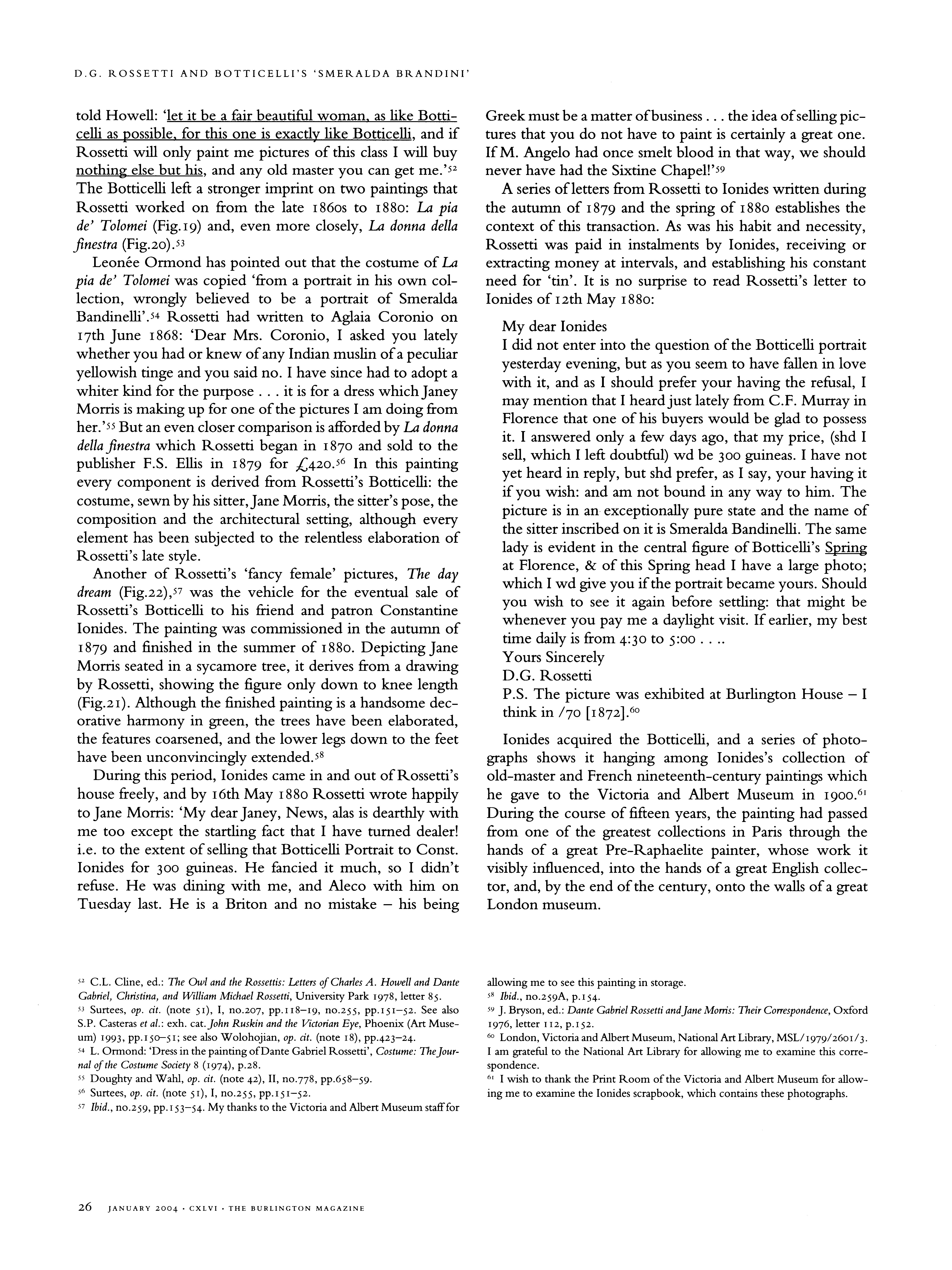
52CL. Cline, ed.: The Owl and theRossettis: Letters ofCharles A. HoweU andDante Gabriel, Christina, andWilliam Michael Rossetti, University Park 1978, letter 85.
53Surtees, op. cit. (note 51), I, no.207, pp.i 18?19, no.255, pp.151?52. See also S.P. Casteras et al: exh. cat.John Ruskin and theVictorian Eye, Phoenix (ArtMuse um) 1993, pp.150?51; see alsoWolohojian, op. cit. (note 18), pp.423?24.
54L. Ormond: 'Dress in the painting of Dante Gabriel Rossetti', Costume: The Jour nal of theCostume Society 8 (1974), p.28.
55 Doughty andWahl, op. cit. (note 42), II, no.778, pp.658?59.
s6 Surtees, op. cit. (note 51), I, no.255, pp. 151-52.
57 Ibid, yno.259, pp. 153-54. My thanks to the Victoria and Albert Museum staff for
allowing me to see this painting in storage.
58 Ibid., no.259A, p.154.
syJ. Bryson, ed.: Dante Gabriel Rossetti andJane Morris: Their Correspondence, Oxford 1976, letter 112, p. 152.
60 London, Victoria andAlbert Museum, National Art Library, MSL/1979/2601/3. I am grateful to the National Art Library for allowing me to examine this corre spondence.
61 Iwish to thank the Print Room of the Victoria and Albert Museum for allow ingme to examine the Ionides scrapbook, which contains these photographs.
